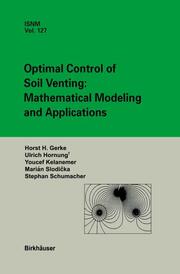Detailansicht
Optimal Control of Soil Venting: Mathematical Modeling and Applications
International Series of Numerical Mathematics 127
Slodicka, Marian/Gerke, Horst H/Hornung, Urs et al
ISBN/EAN: 9783764360412
Umbreit-Nr.: 1652375
Sprache:
Englisch
Umfang: xv, 152 S.
Format in cm:
Einband:
gebundenes Buch
Erschienen am 01.02.1999
- Zusatztext
- Inhaltsangabe1 Introduction.- 1.1 Background and Problem.- 1.2 Objectives.- 1.2.1 Mathematical and Numerical Objectives.- 1.2.2 Objectives of the Optimization.- 2 Modeling Soil Venting.- 2.1 Physical Basis of the Venting Technique.- 2.2 Simulation Models.- 2.2.1 Soil Gas Transport Models.- 2.2.2 Phase Mass Transfer Models.- 2.2.3 Multi-phase Permeability Models.- 2.2.4 Biological Decay.- 2.2.5 Measurement Configuration.- 2.2.6 Heterogeneous Media.- 2.2.7 Structured Soil.- 2.2.8 Mathematical Aspects.- 2.2.9 Remarks on Preferential Gas Flow in Structured Soils.- 3 Stationary Problem and Optimal Control.- 3.1 Basic and State Equations, Objective Function.- 3.1.1 Air Flow.- 3.1.2 Contaminant Transport.- 3.1.3 Optimal Control.- 3.2 Mathematical Analysis, Simplifications.- 3.2.1 Dimensionless Form.- 3.2.2 Approximation of Sinks by Dirac Functions.- 3.2.3 Justification of a Leakage Term.- 3.2.4 Streamline Method.- 4 Well-Posedness and Optimality.- 4.1 Air Flow in a Domain with Holes.- 4.2 Air Flow with Dirac-Type Sinks.- 4.3 Non-smooth Transmissivity at Active Wells.- 4.4 Contaminant Transport in a Domain with Holes.- 4.5 Differentiation of the Transport Equations.- 5 Optimization of Simple Well Configurations.- 5.1 One Single Active Well.- 5.1.1 Constant Volatilization on a Disk.- 5.1.2 Bell-Shaped Volatilization.- 5.2 Two Active Wells.- 5.3 Configurations with a Few Wells.- 6 Estimating the Coefficients.- 6.1 Pedotransfer Model.- 6.1.1 Grouping of Soil Substrates.- 6.1.2 Grouping of the Texture of the Fine Soil Material (equivalent grain diameter smaller than 2 mm).- 6.1.3 Estimation of the Cumulative Particle-Size Distribution.- 6.1.4 Graphical Interpretation of the Particle-Size Distribution.- 6.1.5 Estimation of the Hydraulic Conductivity at Pore Water Saturation.- 6.1.6 Permeability of the Refilled and Rubble Material.- 6.1.7 Analytical Interpretation of the Particle-Size Distribution.- 6.1.8 Residual Water Saturation.- 6.1.9 Hydraulic Parameter Functions.- 6.1.10 Relative Permeability, Saturation-Pressure, and Relative Permeability Relations.- 6.1.11 Pedotransfer Functions, Pressure-Saturation Relations.- 6.1.12 Discussion.- 6.2 Spatial Variability and Uncertainties.- 6.3 Ordinary Kriging.- 6.4 Generation of a Random Field.- 6.5 Parameter Identification of Kertess.- 6.5.1 Calibration of the Transmissivity T, the Leakage L and the Boundary Leakage 1.- 6.5.2 Second Calibration of the Transmissivity T.- 6.5.3 Results of the Calibration of the Air Flow Parameters.- 6.5.4 Calibration of the Volatilization Coefficient V.- 6.5.5 Numerical Minimization Method.- 6.5.6 Results of the Calibration of the Volatilization Coefficient.- 7 Numerical Methods and Optimization.- 7.1 Gas Flow Field.- 7.1.1 Linearity of the Flow Field w.r.t. the Control Variable.- 7.1.2 Mixed Variational Formulation.- 7.1.3 Discrete Variational Formulation.- 7.2 Contaminant Transport.- 7.3 Integrating the Extraction Rate.- 7.4 Optimization Algorithm.- 7.5 Programming Aspects.- 8 Applications.- 8.1 Kertess.- 8.1.1 Optimizing the Extraction Rates.- 8.2 Kirchweyhe.- 8.2.1 Optimizing the Extraction Rates.- 9 Stochastic Optimization.- 9.1 Monte Carlo Optimization.- 9.2 Sensitivity Analysis.- 10 Discussions and Conclusions.- 10.1 Time Dependent Problem.- 10.2 Optimization of Well Positions in Large Scale Applications.- 10.3 Further Aspects of Stochastic Optimization.- 10.3.1 Solution Strategies.- 10.3.2 Solution Strategies.
